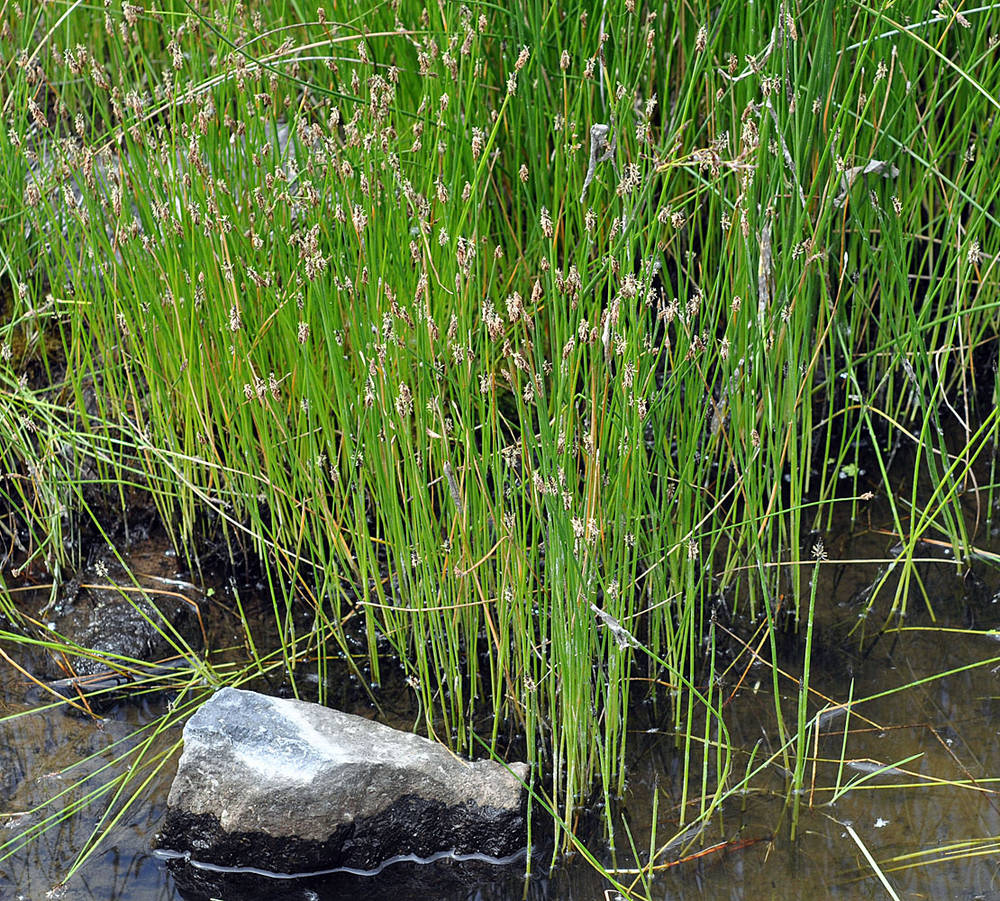Eleocharis engelmannii
Eleocharis palustris
Engelmann's spikerush
common spikerush, creeping spikerush, marsh spikerush
terete, 2–40 cm × 0.5–1.5(2) mm.
terete or slightly compressed, 30–115 cm × 0.5–5 mm.
lanceoloid to subcylindric, 5–10(20) × 2–3(4) mm;
proximal scale empty, encircling approximately 67% of culm; floral scales 25–100(200), 8–12 per mm of rachilla, 2(2.5) × 1–1.3 mm;
apex narrowly rounded to subacute.
ovoid to lanceoloid, 5–25 × 3–7 mm;
proximal scale clasping 67(75)% of culm, subproximal scales 1–2; empty; floral scales 30–100, 4–8 per mm of rachilla, 3–5 × 1.5–2.5 mm;
apex entire; acute or subacute, often keeled in distal part of spike.
perianth bristles present or often absent; (0)5–8; about as long as the achenes;
anthers 0.3–0.7(1) mm;
stigmas 2–3.
perianth bristles 4(5), sometimes absent; much shorter than achene to equaling tubercle, rarely to 2 times as long as achene;
anthers 1.5–2.2 mm;
stigmas 2; very rarely some 3.
biconvex or to 33% greatly compressed trigonous, 0.9–1.1(1.5) × 0.7– 1.1 mm.
biconvex, 1.1–2 × 1–1.5 mm.
persistent, apex of distal leaf sheath obtuse to acute, with tooth to 0.3 mm.
persistent or sometimes disintegrating, often splitting adaxially;
apex lacking tooth.
depressed, subdeltoid, 0.1–0.3(0.4) × 0.6–0.9(1) mm, 10–40% as high as wide, 25% or less as high as achene, 90% as wide as achene.
pyramidal to mammillate; as high as wide to 2 times higher, 0.3–0.7 × 0.35–0.7 mm.
=16, 27, 36.
Eleocharis engelmannii
Eleocharis palustris
Freshwater shores exposed by seasonal low water levels, marshes, disturbed wetlands. 50–500 m. WV. CA, ID, WA; north to British Columbia, east to MA, southeast to AL. Native.
Eleocharis engelmannii is similar to E. ovata and the much more common E. obtusa but has markedly shorter tubercles and usually more cylindric spikes.
Freshwater marshes, lake shores, streamsides, and ponds. 0–2300 m. All ecoregions except Col. CA, ID, NV, WA; north to AK, east to Newfoundland, south to Mexico; Eurasia, New Zealand. Native.
Eleocharis palustris is the most common species in a taxonomically difficult, circumboreal complex of the genus. Its pure, rhizomatous stands can dominate plant communities in shallow wetlands. It can usually be recognized by its subequal proximal and subproximal scales, both lacking flowers. Culm widths overlap those of E. macrostachya, but the very widest spikerush culms in Oregon belong to E. palustris.
Barbara Wilson, Richard Brainerd, Nick Otting
Barbara Wilson, Richard Brainerd, Nick Otting
- Local floras:
BC,
CA,
OR,
WA
- Local Web sites:
CalFlora,
CalPhotos,
Flora NW,
PNW Herbaria
WildflowerSearch
iNaturalist (observations)
USDA Plants Database
- LBJ Wildflower Center
- SEINet
- Plants of the World Online
- Encyclopedia of Life
- Wikipedia
- Google Image Search
- Local floras:
BC,
CA,
OR,
WA
- Local Web sites:
CalFlora,
CalPhotos,
Flora NW,
PNW Herbaria
WildflowerSearch
iNaturalist (observations)
USDA Plants Database
- LBJ Wildflower Center
- SEINet
- Plants of the World Online
- Encyclopedia of Life
- Wikipedia
- Google Image Search




